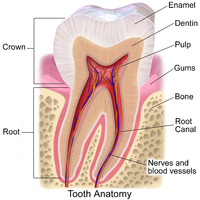
Photo from wikipedia
AIM To investigate attitudes and approaches of UK primary care dentists to carrying out vital pulp treatment (VPT) after carious-exposure and with additional signs and symptoms indicative of irreversible pulpitis.… Click to show full abstract
AIM To investigate attitudes and approaches of UK primary care dentists to carrying out vital pulp treatment (VPT) after carious-exposure and with additional signs and symptoms indicative of irreversible pulpitis. METHODOLOGY An electronic questionnaire was openly distributed via publicly-funded (NHS) local dental committees, corporate dental service-providers, professional societies and social media. Principally NHS practitioners, and those from mixed and private practice were targeted, in addition to community and military dental officers, and dental therapists. Participants were asked questions relating to several clinical scenarios, with responses analysed using descriptive statistics. χ2 tests with sequential Bonferroni correction were used to explore variables including the method of remuneration, practitioner type (dentist/therapist), postgraduate qualification(s), place of graduation and years since qualification. Variables with a relationship p≤0.2 were selected for backwards likelihood ratio logistic modelling. RESULTS In total, 648 primary care practitioners were included for analysis. Calcium hydroxide (CH) was most frequently used for direct pulp caps (DPCs) (398/600; 66.3%) with calcium-silicate cements (CSCs) less frequently used (119/600; 19.8%). Rubber dam was used by 222/599 (37.1%) practitioners. A definitive pulpotomy for the management of teeth with signs a symptoms indicative of irreversible pulpitis was selected by 65/613 (10.6%) dentists. The principal barrier for the provision of definitive pulpotomies was a lack of training (602/612; 98.4%). Regression analysis identified NHS practitioner's as a good predictor for using CH for DPCs, having shorter emergency appointments, limited access to magnification and not using rubber dam. Non-UK graduates were more likely to select CSCs, appropriately control pulpal haemorrhage, undertake appropriate post-operative evaluation and use rubber dam. CONCLUSIONS Practitioners deviated from evidence-based guidelines in a number of aspects including material selection, asepsis and case selection. A number of other challenges exist in primary care in providing predictable VPTs, including lack of time and access to magnification. These were most evident in NHS practice, potentially exacerbating existing social health inequalities. Possible inconsistencies in the UK undergraduate curriculum were supported by a lack of association between years since qualification and technique employed as well as the fact that non-UK graduates and dentists with postgraduate qualifications adhered more to evidence-based VPT guidelines.
Journal Title: International endodontic journal
Year Published: 2021
Link to full text (if available)
Share on Social Media: Sign Up to like & get
recommendations!